|
Handheld Nautiz X8
Handheld Group evolves its Nautiz line with large-screen ultra-rugged mobile computer available with either Windows Embedded Handheld or Android
By Conrad H. Blickenstorfer; photography by Carol Cotton
The Handheld Group introduced the Nautiz X8 on September 23rd, 2014 as the latest member of the company's line of rugged handheld computers that also includes the Nautiz X1, X3, X4, X5, and X7, as well as the Nautiz eTicket models. As the name implies, the Nautiz X8 is the new top of the lineup, designed for those who need a powerful multi-purpose handheld computer with a large capacitive multi-touch display, integrated keypad, one that not only seamlessly fits into existing Microsoft environments, but is available in an Android version as well. RuggedPCReview has had extended hands-on with the Nautiz X8, and this is our report on this tough and rugged mobile computer.
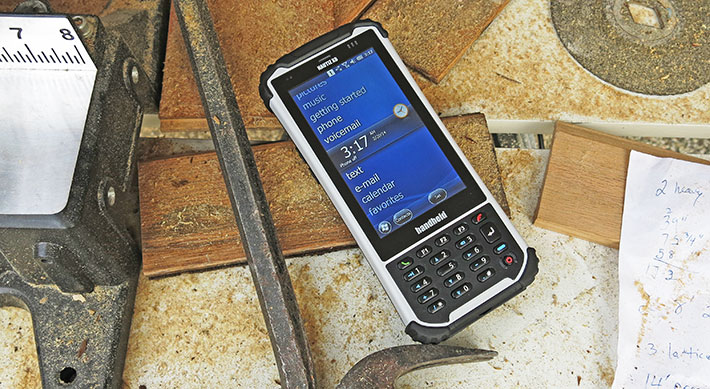
Large and in charge
As is immediately obvious from the picture above, the Nautiz X8, while retaining a purposeful industrial design with an integrated physical keypad and the Handheld Group's distinct light-gray/black color scheme, clearly acknowledges changing user tastes and advancing technologies. The new handheld's display is large, measuring a full 4.7 inches diagonally, the same as that of the iPhone 6. The lineup below shows how the new Nautiz X8 compares to Handheld's full lineup of Nautiz models (click on any to bring up their review page): 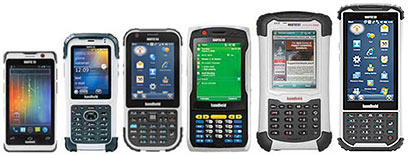
To put the size in perspective, the Nautiz X8 measures 7.5 x 3.1 inches, is 1.2 inches thick, and weighs 17.3 ounces. That's a fairly substantial piece of equipment, though despite its massive ruggedness it actually weighs no more than an iPad Air.
Windows and Android — The fact that this new Nautiz model is available either with the traditional Microsoft Windows Embedded Handheld 6.5.3 or with Android 4.2.2 also shows that times they are a-changin'. Android has now reached a position so strong in consumer smartphones that even the Handheld Group, a longtime provider of enterprise-ready Windows Mobile devices, recently made Android available on its Nautiz X4, and now also on its new Nautiz X8. In this, Handheld participates in a trend we've now been seeing for a good couple of years, that of offering the same or very similar handhelds and tablets in both Microsoft and Android versions. Supporting two operating platforms means extra overhead, but for now it's definitely a wise move as the answer to the Windows vs. Android battle is still, to paraphrase Dylan again, blowing in the wind.
 Fortunately, the availability of processors that can run either Windows or Android makes things considerably easier. One such chip is the 1.5GHz OMAP4470 by Texas Instruments that uses a dual-core ARM Cortex-A9 and two ARM Cortex M3 cores, as well as a PowerVR SGX544 GPU. This same processor is used in high-end Kindle and Nook tablets, as well as in Xplore's RangerX and other higher end handhelds and tablets. Fortunately, the availability of processors that can run either Windows or Android makes things considerably easier. One such chip is the 1.5GHz OMAP4470 by Texas Instruments that uses a dual-core ARM Cortex-A9 and two ARM Cortex M3 cores, as well as a PowerVR SGX544 GPU. This same processor is used in high-end Kindle and Nook tablets, as well as in Xplore's RangerX and other higher end handhelds and tablets.
The chip performed excellently in the Xplore tablet we tested, and it also gives the Nautiz X8 plenty of punch. Remember, Windows Embedded Handheld was designed to work just fine with much slower processors than the one in the Nautiz X8.
The good performance of the OMAP 4470 and its ability to run both the Microsoft OS as well as Android also made it unnecessary for Handheld to use different processors for the two versions, or the same processor with different speeds, a practice employed in some other companies' lineups that include multi-OS devices.
On the memory side there is 1GB of RAM and 4GB of Flash. The specs also include a user-accessible MicroSD expansion card slot, as well as a SIM card slot.
Big, bright procap display with Dragontrail — The sunlight-readable 4.7-inch display offers 854 x 480 pixel resolution. That makes for a wide-format (or tall-format in the case of a handheld) 16:9 aspect ratio, and a pixel density of around 210 dpi. That's less than leading modern consumer smartphones, but still about the same as Microsoft's Surface Pro 2 tablet or a "retina" MacBook Pro. The display is very bright as well, 600 nits. And it uses Asahi "Dragontrail" strengthened glass, an impressive competitor to Corning's ever-present Gorilla Glass.
After the Android-only Nautiz X1, the Nautiz X8 is the Handheld Group's second device that uses capacitive instead of resistive touch. Capacitive touch, of course, is a natural for Android, which was designed around that technology. It's somewhat less well suited for Windows Embedded Handheld, which was retrofitted for touch, but was really designed for use with a resistive stylus.
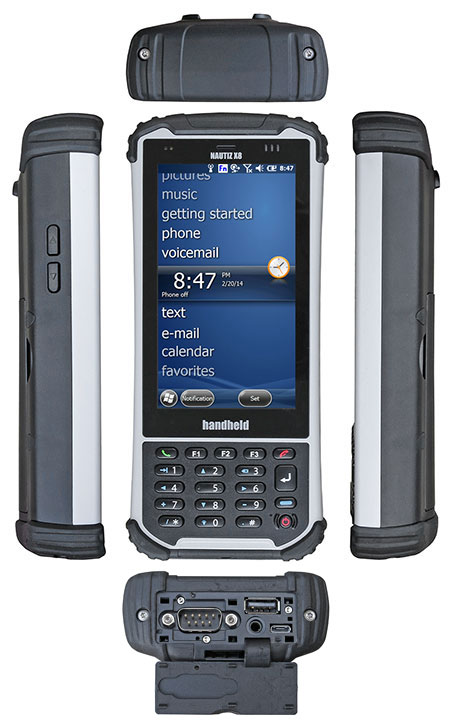 Physical keypad — Unlike consumer smartphones, the Nautiz X8, like all of the company's devices except one, has a physical keypad. That's because there remain many tasks where a physical pad with its precision and tactile feedback remains preferable. The keypad also contains three programmable keys, and though we haven't seen the Android version of the Nautiz X8 yet, we assume those three keys will be assigned to the standard Android Menu - Home - Back functions. There are no separate physical directional keys but they are available as secondary functions. The Nautiz X8 also includes the standard phone call pick-up and hang-up keys. Physical keypad — Unlike consumer smartphones, the Nautiz X8, like all of the company's devices except one, has a physical keypad. That's because there remain many tasks where a physical pad with its precision and tactile feedback remains preferable. The keypad also contains three programmable keys, and though we haven't seen the Android version of the Nautiz X8 yet, we assume those three keys will be assigned to the standard Android Menu - Home - Back functions. There are no separate physical directional keys but they are available as secondary functions. The Nautiz X8 also includes the standard phone call pick-up and hang-up keys.
Well equipped and extension caps — The Nautiz X8 has a rear-facing 8.0-megapixel autofocus camera with LED flash for documentation purposes. For wireless connectivity there is 802.11b/g/n WiFi and Class 2 (the kind that has a 30+ foot range) Bluetooth version 2.0 for Windows and 3.0 for Android. On the WWAN side, the Nautiz X8 can be equipped with 3.8G GSM HSPA+/HSUPA or CDMA EVDO Rev. A for wide area voice and data communication.
The device also comes with integrated u-blox GPS. Unlike the recent Nautiz X4, the Nautiz X8 doesn't have an integrated industrial-grade scanner. Instead, the company refers to an open architecture and an extension cap system that allows connection of additional hardware such as sensors, radios and other add-ons (including, presumably, scanners).
Visually, the Nautiz X8 fits perfectly into Handheld's distinctive design language with light-gray plastics and black protective cladding and bumpers, continuing the company's pursuit of a clear visual brand identity for their Algiz and Nautiz lines.
Rich I/O — unlike consumer smartphones or smaller industrial handhelds that often make do with a single connector, the Nautiz X8 offers a full complement of industry-standard wired connectivity. There's a full-size USB 2.0 port, a full-size DB9 RS232 serial port for legacy connectivity, a microUSB port for charging and syncing with desktops and laptops, and a standard-size 3.5mm stereo and microphone jack.
As we've come to expect from Handheld, the Nautiz X8 housing is elegant, cleanly designed, ergonomic and very and functional. There are few visible screws and no small parts or delicate features that might get damaged or break off. The device feels extremely solid and created for hard use in the field. The black rubberized bumpers are design elements as well as protection. They are screwed on and can easily be replaced.
A closer look at the Nautiz X8
The Handheld Group has always excelled in offering products that are truly, thoroughly rugged, yet also nicely designed, ergonomic, and pleasing to the eye. The Nautiz X8 is no different. It may be a tough tool for the job, but it's a good-looking one, and one whose beauty is more than just skin-deep. Which is good as it's what's inside that really matters in a device that must hold up to bumps and abuse out there on the job. That's why we take devices apart and examine what they're made of inside. We also believe that providing that information helps distributors and system integrators get an understanding of customizable a device will be, and how easy it is to service.
The pictures below show the backside of the Nautiz X8 fully assembled on the left, and with the battery and battery cover removed on the right. in between are the battery and the battery compartment cover.

The sturdy battery compartment cover consists of ABS+/PC polycarbonate. It has a red replaceable rubber o-ring to keep liquids from entering the compartment. That's crucial as inside is not only the battery, but also access to the interior of the device. The compartment cover snaps into place and is secured by a spring-loaded lever. It will not come loose by accident.
The battery itself uses Li-Ion technology. It is rated 3.7 Volts, 5,200 mAH, for a total of 19.2 watt-hours. The battery looks like a large camcorder battery and is manufactured specifically for Handheld by ETI CA Battery Inc.
Like other members of the Nautiz line, the Nautiz X8 consists of an interior magnesium frame encased in a light-gray polycarbonate upper half and black polycarbonate lower half. The two halves of the case are secured together with eight Torx 9 screws, but it takes more than removing those screws to get the halves apart. There are the top and bottom protective rubber end caps held in place by two each T9 Torx screws. The bottom cap provides access to the unit's elaborate I/O, is additionally secured with three Torx T6 screws and a couple of 5mm hex nuts.
The replaceable I/O block, which also has an orange o-ring to completely seal the opening (and the block itself, despite its many ports, is sealed as well), has a short ribbon cable that slides into a ribbon connector inside the unit. The connection is covered by first a piece of tape and then a small plastic cover. All this must be removed to get to two final T6 Torx screws before the two halves can be separated. All of this makes the Nautiz X8 somewhat more challenging to open and service.
Below you can see the bottom half of the Nautiz X8 on the left and the top half on the right. in between is a close-up of the unit's I/O block with its ribbon cable.
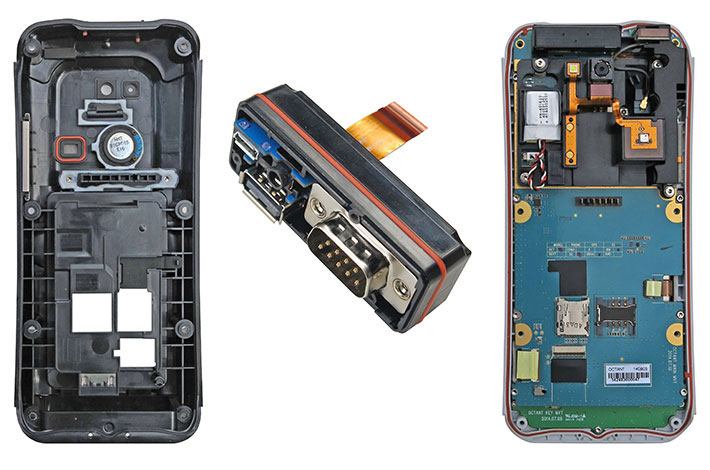
The two halves that make the Nautiz X8's housing are sealed against each other with a tongue-and-groove arrangement. The groove part is in the light-gray top half. Inside the groove sits a replaceable orange o-ring seal.
The black bottom half of the housing is structurally very tough and very rigid. There are even coffer enforcements to add even more rigidity. Equally impressive is the very neatly applied white silicone glue sealing any part with any connection to the exterior. And just as impressive are the small orange o-rings that provide seals wherever necessary.
You don't see a lot of electronics inside the Nautiz X8. That's in part because a lot of the visible electronics are integrated and/or covered by a black plastic cowl, as is the case in other Handheld devices. To another part it's because the Nautiz X8 has two full size boards inside, one on top and the other underneath what appears to be a solid magnesium frame a bit less than 1/8th of an inch thick. Several flat ribbon cable seem to connect the two boards. We generally don't like to see those as they are finicky to handle and the tiny plastic retainers that hold them in place are fragile. The frame itself is impressive, secured to the top half of the unit, provides additional strength, making the Nautiz X8 one rigid unit indeed.
On top of the unit is an embedded expansion connector for custom hardware integrations in conjunction with special expansion caps. USB Host, serial, and 3.3v/5v power are all available via this (proprietary) connector.
When we reviewed Handheld's Nautiz X3 we had had some concerns about that unit's combining USB, power and audio all into one non-standard universal port. We prefer the Nautiz X8's arrangement that separates things into individual serial, USB, micro-USB and audio ports. We do wish, however, there were more rugged versions of the standard micro-USB port.
Overall, the Nautiz X8 is a clean and solid design inside and out. Everything is tightly secured, nothing rattles or seems in danger of coming loose. We like like the logically routed, easily replaceable, and highly visible seal between the two housing halves, as well as the easily replaceable additional o-ring seals. Not everything gets an A+ though. We're not crazy about the short ribbon cable of the I/O module, and the protective cover of the I/O block is hard to properly insert and pry out.
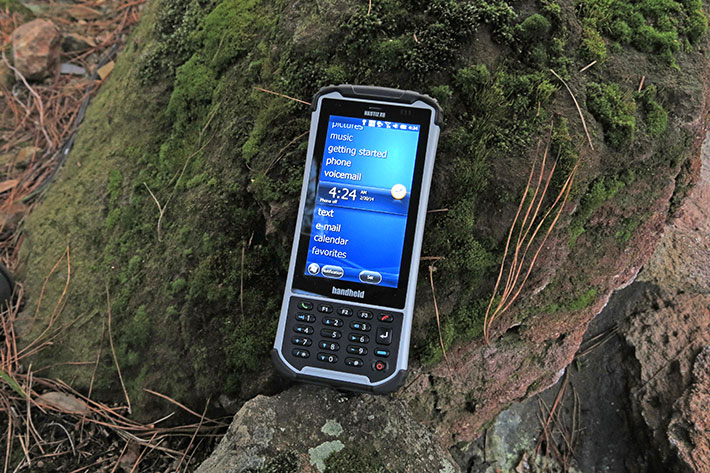
Windows Embedded Handheld 6.5
Our test Nautiz X8 came with Microsoft's Windows Embedded Handheld 6.5, which is the venerable Windows Mobile 6.5 with a different name. This is Microsoft's mini-OS that once, well over a decade ago, was the standard for Pocket PCs, long before the world moved on to iPhones and Android. Old though it is, Windows Embedded Handheld is still very widely used because a) it works, b) it's fully compatible with Microsoft's software infrastructure, and c) Microsoft hasn't come up with anything more compelling to replace it in industrial handhelds.
 Just to explain its position in the world, Windows Mobile/Embedded Handheld 6.5 was, and is, the final version of Windows Mobile before Microsoft split development into the consumer-oriented Windows Phone 7/8 and the industrial device-oriented Windows Embedded Compact, which never really caught on anywhere. With the final 6.5.3 version Microsoft modernized Windows Mobile a bit by borrowing both the icon interface of the iPhone and also design elements from their own short-lived Zune music player. Underneath that veneer are the legacy Windows Mobile screens and functionality. Just to explain its position in the world, Windows Mobile/Embedded Handheld 6.5 was, and is, the final version of Windows Mobile before Microsoft split development into the consumer-oriented Windows Phone 7/8 and the industrial device-oriented Windows Embedded Compact, which never really caught on anywhere. With the final 6.5.3 version Microsoft modernized Windows Mobile a bit by borrowing both the icon interface of the iPhone and also design elements from their own short-lived Zune music player. Underneath that veneer are the legacy Windows Mobile screens and functionality.
For those used to earlier versions of Windows Mobile, things look pretty much the same as they always have. There is a lefthand-adjusted list of the major device functions (such as phone, email, calendar, favorites, Windows Live, etc.). Then there is a horizontal bar in the middle of the screen that provides current information. Under Pictures it'd show the last one viewed, under Phone the missed calls, under Emails how many new ones are waiting to be read, under Calendar your current appointments, and so on. You can drag the list of topics up and down, and you can also drag the detail viewer bar up and down. It's an approach that's unusual at first, and it's quite easy to drag the wrong element, but you quickly get used to it and it's a good way to know what's going on.
The pictures below show the Windows Embedded Handheld 6.5 Home (left) and Start (center) screens, as well as the Settings screen with all the utilities and control panels.
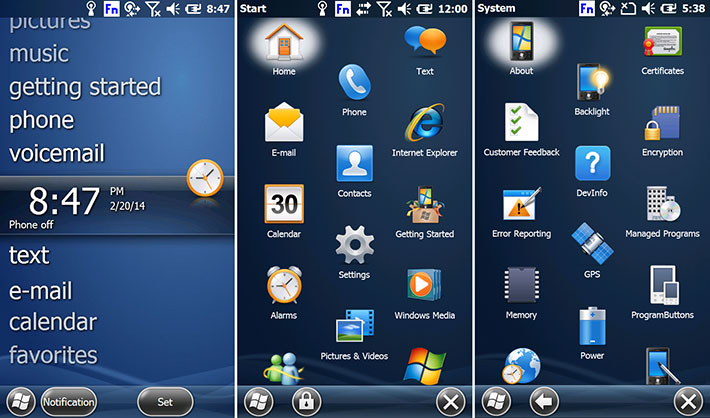
With the effortless elegance of projected capacitive touch now pretty much expected by hundreds of millions of smartphone users, it made sense for the Nautiz X8 to switch to it as well. Earlier versions of Windows Mobile were very clearly designed for use with a stylus, but the Home, Start and System screens of Embedded Handheld 6.5.3 work just fine with capacitive touch, and especially so on a nice, large screen as the Nautiz X8 has. In addition, the Nautiz X8 is also available with Android, and Android works much better with capacitive touch than with a stylus.
On the Nautiz X8, Windows Embedded Handheld includes the mobile versions of the Microsoft Office apps (Word, Excel, Powerpoint, SharePoint and even OneNote). They are limited, of course, and using a conventional spreadsheet with just finger touch isn't much fun even on a relatively large 4.7-inch screen. Word and Powerpoint can come in handy, and SharePoint and OneNote may undoubtedly be appreciated by some customers as well. It is possible to hook up an external keyboard to make lengthy data entry a whole lot easier. The various handwriting recognition options that used to be part of Windows Mobile for so long are not included on the Nautiz X8. We miss them, but they really require a pen or stylus and were not designed for use with touch.
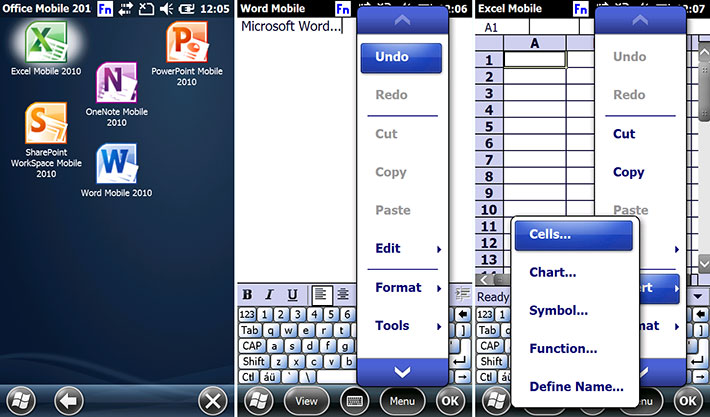
Web browsing on a 4.7-inch display with capacitive touch is quite possible, although the version of Internet Explorer that comes with Embedded Handheld does not make it a great pleasure. No pinching and zooming here, but WEH 6.5 has a large zoom slider that makes it fairly easy to move in and out. All fonts remain sharp when zoomed. It's clear, though, that the web was a much simpler place when Windows Mobile was conceived, as browsing today's complex sites is slow even with the Nautiz X8's powerful processor.
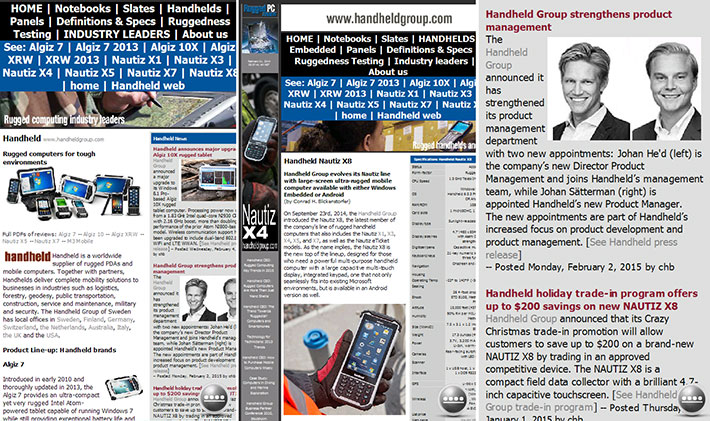
Windows CE/Mobile has always had numerous utilities, control panels and applets, and that's no different in Windows Embedded Handheld. below are examples of some of the control panels and setting screens.
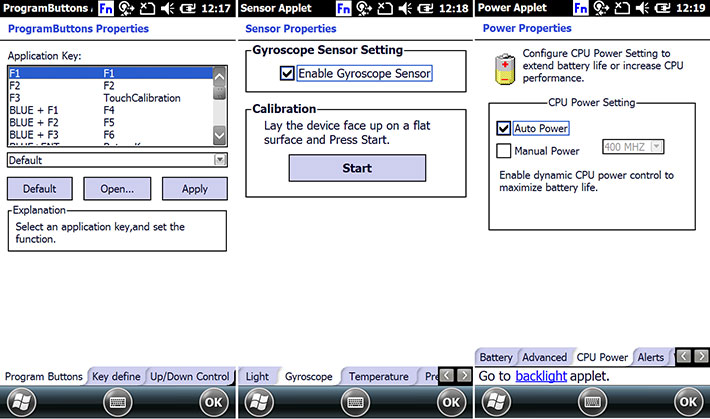
It used to be that downloading and installing applications on Windows Mobile devices was easy. If you had internet access, all you needed to do is load the Microsoft Marketplace app, then sign in with your Windows Live or Hotmail ID. When we reviewed earlier Nautiz handhelds, we always immediately downloaded some of the essentials we couldn't do without. Windows Marketplace didn't have the sheer number of apps as the Apple AppStore, but there were plenty to choose from. Unfortunately, Microsoft closed down the Windows Marketplace for Mobile in 2012, and that was that. No more downloads.
What it all means is that in devices such as the Nautiz X8, Windows Embedded Handheld simply serves the purpose of a mature, field-proven and very well supported OS platform to run custom software on.
Phone functionality
In this day and age where virtually everyone has a super-competent consumer smartphone, it seems hardly necessary to highlight the phone capabilities of a rugged industrial handheld. But while Handheld doesn't push it, the Nautiz X8 does have the physical green and red phone pickup and hangup buttons that used to be on all phones when they still had physical keypads. So yes, the Nautiz X8 can be used as a phone. Simply insert a SIM card and as long as you have an activated account for it, the Nautiz X8 becomes a very serviceable smartphone.
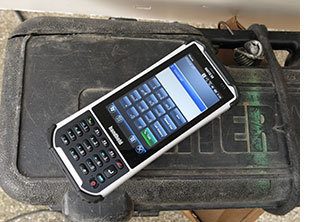 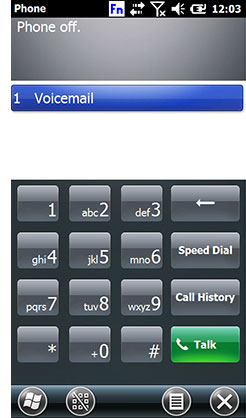 Few probably remember that Microsoft, its current dismal phone market share notwithstanding, offered advanced voice capabilities in its Pocket PC platform years before the iPhone even existed. And they had gotten it right. As a result, even today, all the phone functionality in WEH works and everything is logical and nicely integrated. The Nautiz X8's voice quality is very good, and, as is often the case with vertical market handhelds that are also phones, the sound is actually better than the disappointingly tinny audio from most of today's smartphones. And since the phone functionality goes back to the "Pocket PC Phone Edition," the wireless capabilities are deeply integrated into the device and its software. Few probably remember that Microsoft, its current dismal phone market share notwithstanding, offered advanced voice capabilities in its Pocket PC platform years before the iPhone even existed. And they had gotten it right. As a result, even today, all the phone functionality in WEH works and everything is logical and nicely integrated. The Nautiz X8's voice quality is very good, and, as is often the case with vertical market handhelds that are also phones, the sound is actually better than the disappointingly tinny audio from most of today's smartphones. And since the phone functionality goes back to the "Pocket PC Phone Edition," the wireless capabilities are deeply integrated into the device and its software.
To use the Nautiz X8 as a phone, you simply push the green button. The phone application then shows the last calls, an onscreen keypad, and access to call logs and speed dial. The call log provides summary information about the number of calls and call time. Individual call log entries provide one-button call-back or SMS messaging as well as access to any notes that may be attached to a call. Or you can create a new Contacts entry automatically. You can also take notes during a call. The note will have the caller's name, the phone number, and the time of the call already on it. Needless to say, to take a note you'll have to use the Nautiz X8 with headphones and with the speakerphone on. Volume for the phone can be set separately from the system itself via a balloon slider box that is always accessible via the menu bar on top of the display.
What all this means is that the Nautiz X8 can be used as a phone in addition to everything else it does.
Communication, connectivity and data capture
Comprehensive communications capabilities are an integral part of any mobile computing device today, and so the Nautiz X8 was designed to connect in many ways. For a handheld device, there is rich onboard wired connectivity. We were glad to also see a separate micro-USB connector for charging or communication.
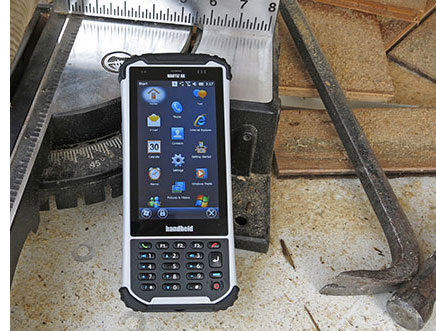 The Nautiz X8 comes standard with integrated 802.11b/g/n WiFi and there is Bluetooth V2.0 (V3.0 in Android versions). A SIM slot, located inside the battery compartment, enables the unit to function as a phone and also provides access to the integrated quad-band GSM/CDMA radio as well as five-band UMTS and HSPA+ (Evolved High-Speed Packet Access) services. HSPA+ is a mobile communications protocol that enhances 3G speeds and can operate on the 800/850/900/1900/2100MHz bands. The Nautiz X8 comes standard with integrated 802.11b/g/n WiFi and there is Bluetooth V2.0 (V3.0 in Android versions). A SIM slot, located inside the battery compartment, enables the unit to function as a phone and also provides access to the integrated quad-band GSM/CDMA radio as well as five-band UMTS and HSPA+ (Evolved High-Speed Packet Access) services. HSPA+ is a mobile communications protocol that enhances 3G speeds and can operate on the 800/850/900/1900/2100MHz bands.
When within range of a network, WiFi can be used for web browsing, email, terminal emulation sessions, synchronization or, thanks to the unit's microphone and speaker and assuming the necessary software is installed, for VoIP (Voice over IP) voice communication.
Connection to a PC for synchronizing or communication with a backend server or peripheral can be via USB, WiFi, WWAN, or Bluetooth. Relationships can be established via standard Microsoft ActiveSync (we used the Windows Mobile Device Center Version 6.1 for testing).
The Nautiz X8 also includes both standalone (meaning it works additional RF components) and assisted GPS. The unit's u-blox7 multi-GNSS receiver provides high sensitivity GPS functionality but the manual only refers to a u-blox chipset and not the exact model, so we're not sure of the GPS specs and what degree of accuracy can be expected. We'd also have liked to test GPS with Google Maps as we did with earlier Nautiz handhelds but, alas, with the Microsoft Marketplace gone, it's no longer available.
8-megapixel camera
Virtually all modern smartphones have built-in cameras these days, and those cameras are now so good that they have essentially eliminated the dedicated compact camera market. Tiny high quality camera circuitry is available and fits into even the smallest spaces. Up to recently, cameras built into vertical market rugged handhelds have seriously lagged behind, not living up to the promise that adding camera functionality to such devices allowed field personnel to document project conditions, findings, reports, etc. This is starting to change. A Handheld Nautiz 4 we tested in early 2014 had a workable camera. How is the one in the Nautiz X8?
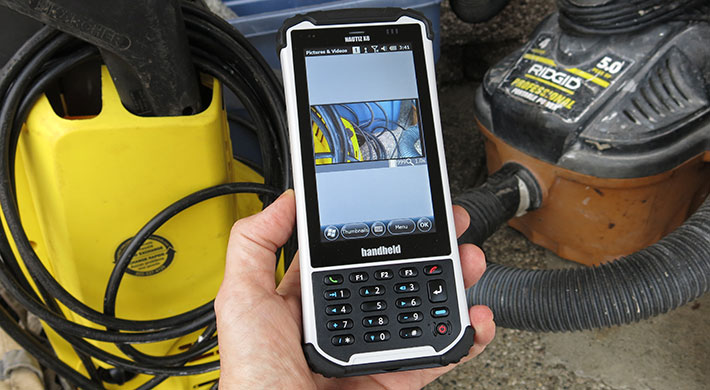
The answer is "pretty good." The Nautiz X8's integrated documentation camera can snap images with resolutions of up to 8 megapixel. It also has an LED illuminator that you can turn on and off via software to add extra light. Unlike earlier LED flashes that were more like illuminators, this one acts more like a regular flash and helps making better pictures in marginal lighting conditions.
The camera can take pictures with resolutions ranging from 320 x 240 pixels all the way up to full 3264 x 2448 pixels (8mp). Default operation is via the Pictures & Videos application that offers a good variety of image capture and playback options. You can play slide shows, designate a picture as the Today wallpaper, beam a shot via Bluetooth, email in various sizes, and so on. In capture mode you can set a 5-second self-timer or do 5-picture burst mode (not very fast but maybe still useful) and you can also set brightness. In video mode you can record up to 352 x 288 pixels and set time limits (15 seconds, 30 seconds or unlimited). Given that the imager can do 8mp stills, the low 352 x 288 pixel video must be a Windows Embedded Handheld limitation; 8mp should be plenty enough to record in full 1080p.
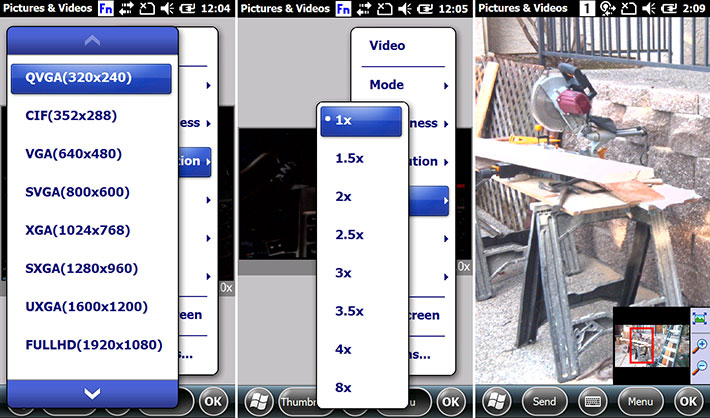
Imaging is probably another area where the Nautiz X8's hardware is years ahead of its legacy Windows Mobile software. There is enough processing power, enough imager and display real estate, and enough camera hardware for contemporary still and video, but the standard OS Pictures & Videos app just doesn't support it. The DevInfo app suggests that the camera is an AR0833, which would indicate an Aptina 8-megapixel 1/3.2-inch BSI CMOS imager (see spec sheet here) which is inherently capable of full-speed 1080p HD video. It therefore seems entirely possible that custom software would make the full capabilities of the camera available.
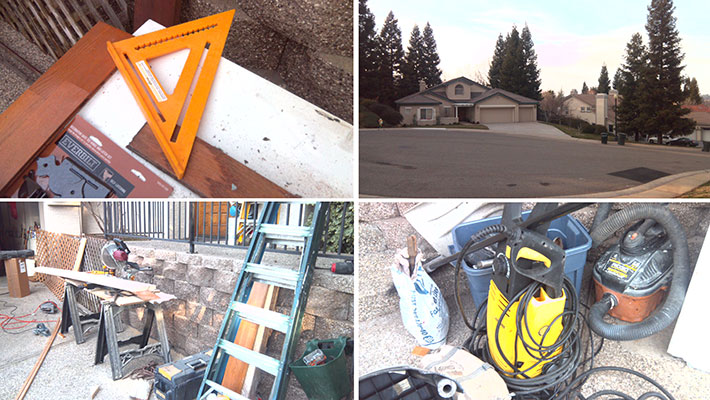
As is, even with the standard Windows Mobile app, the camera is capable of taking much better pictures than we've seen in the past from industrial handhelds. There is decent sharpness and image detail, and none of the massive compression that often renders pictures from such integrated cameras useless. Click on the above compilation for a full-size version to examine full-size picture quality is.
Video, likewise, is improved compared to what we often see from the cameras in rugged devices of the past. Frame rate and focussing are quick enough to be used on the job. The 352 x 288 pixel CIF size, of course, is much too small for most uses. The video to the right was taken with the Nautiz X8 camera in 352 x 288 resolution. It's an example of a clip a mechanic might shoot as an attachment to a work order.
So again, note that the limited Camera application that comes with Microsoft Windows Embedded Handheld is often replaced by third party applications that work much better and have much greater capabilities, or developers and systems integrators include camera and video functionality directly into custom applications.
From what we can tell, the Aptina camera hardware of the Nautiz X8 may well be good enough for documentation jobs.
Power
The Nautiz X8 is powered by a rechargeable 5,200mAh 3,7 Volt Lithium-Ion battery. This amounts to 19.2 watt-hours—generous for this class of device. Handheld estimates battery life between charges to be up to 12 hours of continuous operation. It's definitely good enough to make it through even a very long workday on a single charge. The battery compartment cover with its springloaded lever is easily opened, and the battery easily replaced for a freshly charged one.
Ruggedness
A lot of consumer market devices claim to be rugged these days. The trend may have been started with "outdoor" cameras that could be dropped, frozen, stepped on, driven over, and even taken on scuba dives. More recently, we've been seeing "active" versions of standard consumer smartphones sporting, despite their glitzy slenderness, the same stellar IP67 ingress protection rating as some of the stoutest dedicated rugged computing gear. Does that make then as tough as fully rugged gear?
Not even close. One look at the Nautiz X8 makes it clear that users won't have to worry it getting bent, chipped, cracked or broken. Comparing the Nautiz 8 with even an IP67 rated smartphone is like comparing a golfball with a raw egg. Both may be waterproof, but that's where the similarity ends.
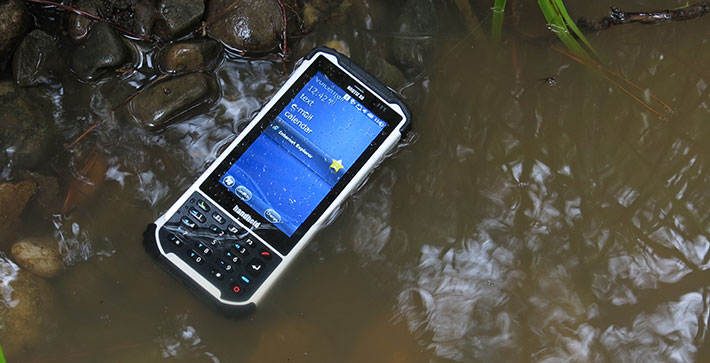
In terms of sealing from the elements, an ultra-rugged device like the Nautiz X8 should be totally dustproof and also totally waterproof, and the Nautiz X8 is, carrying an IP67 rating. The "6" in the rating means it's totally dustproof, and the "7" that it can't only be hosed down, but can even handle full immersion into up to a meter (3.3 feet) of water. So everything goes with the Nautiz X8, even dropping it into a stream won't damage it.
Anything used as a handheld computer or a phone can and will eventually be dropped. The US MIL-STD-810G military standard suggests a drop height from four feet, because that's as far as something carried will usually fall. Since one holds a phone against one's ear, reason would have it that it should be able to handle a drop from about five feet. As is, Handheld tested the Nautiz X8 for in accordance with the procedures specified in MIL- STD 810G, Method 516.6, Procedure IV. That means 26 4-foot drops. Handheld also tested for "tumbles." That simulates the device falling off a truck or slipping out of hands while walking. The tested 500 tumbles are probably more than any mobile computer will encounter during its lifespan.
Vibration can be an issue if a device rattles around in a vehicle or if it's mounted on something that vibrates a lot. Here, Handheld tested according to MIL-STD-810G, Method 514.6, Procedures I (general vibration) and II (loose cargo).
A rugged device must be able to function properly in a wide range of temperatures. The Nautiz X8 can handle a very wide range from -22 to 140 degrees Fahrenheit (-30°C to 60°C). This means it can be used even in commercial freezers as well as in the worst desert-like conditions.
Commercial aircraft cabins are generally pressurized to the equivalent of about 7,000 feet altitude, but industrial and military craft are a different story, or there may be a mountain expedition. Handheld claims a 15,000 feet (about 4600 meters) altitude limit.
Overall, the Nautiz X8 covers all pertinent ruggedness criteria. It seems able to survive pretty much any punishment.
Summary
The Nautiz X8 represents a logical evolution of the Handheld Group's impressive line of rugged handhelds. The new device addresses both evolving customer demands (like a larger display and capacitive multi-touch) as well as market trends (like the growing importance of Android), 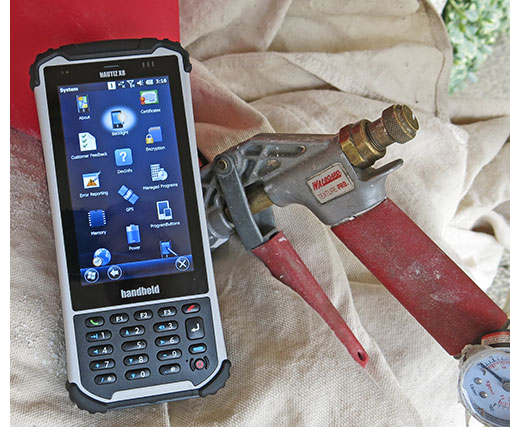 while retaining the company's strong product DNA, uncompromising commitment to full ruggedness, and meticulous dedication to legacy and enterprise support. while retaining the company's strong product DNA, uncompromising commitment to full ruggedness, and meticulous dedication to legacy and enterprise support.
Like all of the Handheld Group's rugged devices, the Nautiz X8 comes in a package that skillfully merges legacy functionality, contemporary performance, and pleasing design. The Nautiz X8 is a multi-purpose handheld terminal that's a powerful computer, a competent phone, a navigator and a super-tough data collector that, without trial and error, fits right into the Microsoft enterprise infrastructure still widely deployed around the globe. And since this exact same platform can also run Android, the Nautiz X8 is an ideal device to examine Android, its potential in vertical deployments, and the ease of converting applications.
Equipped with a bright, sharp and nicely-sized 4.7-inch capacitive touch display that can be viewed from any angle, the Nautiz X8 can easily be operated both with fingers using the large touch controls, or with the included capacitive stylus when a bit more precision is required.
The Nautiz X8 can function both as a data collection device as well as a GSM/UMTS or CDMA smartphone and data communicator (all you have to do is insert an activated SIM). Despite its very wide temperature tolerance, stellar IP67 sealing and ability to survive 4-foot drops, the very tough Nautiz X8 still weighs barely more than a pound. Featuring elegant industrial design and a large, modern capacitive touch screen, it's a very well-made and trust-inspiring tool for the job.
Able to withstand almost infinitely more punishment than any smartphone, the Nautiz X8 combines a lot of functionality into one handy package. There's integrated GPS for mapping and GIS applications. An internal 8-megapixel camera with LED illuminator light can be used to document data and shoot video. Replaceable end-caps and a special expansion connector allow for custom functionality. The physical numeric keypad allows for very rapid data entry. The unit's powerful replaceable battery provides full-day operation and beyond.
The Nautiz X8 may have the large screen and capacitive touch interface of a modern smartphone, and it can be used as a phone, but this is really a nearly indestructible mobile computer designed for reliable data capture and data communication tasks out there in the field. It fits right into most enterprise infrastructures, and it's available with Android as well.
-- Conrad H. Blickenstorfer, February 2015
Update: On August 25, 2015, the Handheld Group announced three expansion packs for the Nautiz X8. A Long Range Bluetooth (LRBT) Expansion Pack allows long-range communication up to 300 meters, using a LRBT u-blox module. A Barcode Expansion Pack features a Zebra SE4750SR imager with LED aimer. And there is also a Nautiz X8 Basic Expansion Pack with an empty add-on cap for an extension of your choice, allowing users to install custom accessories under the cap using the proprietary interface. All cap versions are designed to retain the Nautiz X8 IP67 classification.
Handheld Nautiz X8 Specs:
| Added/changed |
Added 09/2014; full review 02/2015, updated 08/2015
|
| Type |
Rugged handheld
|
| Processor |
1.5 GHz Texas Instruments OMAP4470 |
| OS |
Windows Embedded Handheld 6.5.3 Professional OR Android 4.2.2
|
| GPS |
u-blox GPS module
|
| RAM/ROM |
1GB/4GB Flash |
| Display |
4.7" sunlight-readable (600 nits) TFT with 480 x 854 pixel resolution, Asahi Dragontrail strengthened glass |
| Digitizer |
Capacitive multi-touch/1
|
| Keyboard/keys |
28-key numeric or QWERTY backlit keypad |
| Navigation |
21-key numeric keypad with three function keys
|
| Expansion slots |
1 x microSDHC, 1 x SIM (user accessible)
|
| Housing |
PC+/ABS polycarbonate with magnesium alloy chassis and removable rubber bumpers
|
| Size |
7.5 x 3.1 x 1.2 inches (191 x 80 x 35 mm)
|
| Weight |
17.3 ounces (490 grams)
|
| Operating temperature |
-22° to 140°F (-30° to 60°C) per MIL-STD-810G 501.5/502.5 I, II and III |
| Ingress protection |
IP67 |
| Humidity |
90% RH per MIL-STD-810G, Method 507.5 II |
| Drop |
26 4-foot drops per MIL- STD 810G, Method 516.6, Procedure IV |
| Vibration |
MIL-STD-810G, Method 514.6, Procedure I and II, Category 5 |
| Altitude |
15.000 ft (4572 m) at 73°F (22°C) |
| Tumble |
500 1-meter (3.3 feet) tumbles |
| ESD |
estimated: IEC61000-4-2 / EN55024 |
| Power |
3.7V, 5,200 mAH 19.2 whr Li-Ion, warm-swappable |
| Regulatory |
??????? FCC, CE and A/C-Tick |
| Camera |
Rear-facing autofocus 8.0mp with LED illuminator |
| Sensors |
3-axis accelerometer, 3-axis gyroscope, ambient light sensor, digital compass, altimeter/barometer, proximity sensor, ambient temperature |
| Communication |
802.11b/g/n WiFi, Bluetooth 2.0 (WinMo) or 3.0 (Android), WWAN (3.8G GSM HSPA+/HSUPA or CDMA EVDO Rev. A); optional via expansion packs: Long Range Bluetooth (up to 300 meters), barcode (Zebra SE4750SR) |
| Interface |
1 x USB host, 1 x micro USB, 1 x DO9 RS232, 3.5mm audio |
| Price |
Inquire |
| Spec sheet |
Handheld Nautiz X8 spec sheet (PDF)
|
| Web page |
Nautiz X8 page |
| Manual |
 Nautiz X8 manual Nautiz X8 manual |
| Contact |
Handheld Group AB
Kinnegatan 17A
531 33 Lidköping, Sweden
Tel: +46 (0) 510 54 71 70
Fax: +46 (0) 510 282 05
Web: www.handheldgroup.com
Email: info at handheldgroup.com
|
HHCS Handheld USA Inc.
33870 SE Eastgate Circle
Corvallis, OR 97333, USA
Tel: (541) 752-0313
Fax: (541) 752-0338
Web: www.handheld-us.com
Email: info at handheld-us.com
|
(copyright 2015 RuggedPCReview.com)
|






 Fortunately, the availability of processors that can run either Windows or Android makes things considerably easier. One such chip is the 1.5GHz OMAP4470 by Texas Instruments that uses a dual-core ARM Cortex-A9 and two ARM Cortex M3 cores, as well as a PowerVR SGX544 GPU. This same processor is used in high-end Kindle and Nook tablets, as well as in Xplore's RangerX and other higher end handhelds and tablets.
Fortunately, the availability of processors that can run either Windows or Android makes things considerably easier. One such chip is the 1.5GHz OMAP4470 by Texas Instruments that uses a dual-core ARM Cortex-A9 and two ARM Cortex M3 cores, as well as a PowerVR SGX544 GPU. This same processor is used in high-end Kindle and Nook tablets, as well as in Xplore's RangerX and other higher end handhelds and tablets.
 Physical keypad — Unlike consumer smartphones, the Nautiz X8, like all of the company's devices except one, has a physical keypad. That's because there remain many tasks where a physical pad with its precision and tactile feedback remains preferable. The keypad also contains three programmable keys, and though we haven't seen the Android version of the Nautiz X8 yet, we assume those three keys will be assigned to the standard Android Menu - Home - Back functions. There are no separate physical directional keys but they are available as secondary functions. The Nautiz X8 also includes the standard phone call pick-up and hang-up keys.
Physical keypad — Unlike consumer smartphones, the Nautiz X8, like all of the company's devices except one, has a physical keypad. That's because there remain many tasks where a physical pad with its precision and tactile feedback remains preferable. The keypad also contains three programmable keys, and though we haven't seen the Android version of the Nautiz X8 yet, we assume those three keys will be assigned to the standard Android Menu - Home - Back functions. There are no separate physical directional keys but they are available as secondary functions. The Nautiz X8 also includes the standard phone call pick-up and hang-up keys.



 Just to explain its position in the world, Windows Mobile/Embedded Handheld 6.5 was, and is, the final version of Windows Mobile before Microsoft split development into the consumer-oriented Windows Phone 7/8 and the industrial device-oriented Windows Embedded Compact, which never really caught on anywhere. With the final 6.5.3 version Microsoft modernized Windows Mobile a bit by borrowing both the icon interface of the iPhone and also design elements from their own short-lived Zune music player. Underneath that veneer are the legacy Windows Mobile screens and functionality.
Just to explain its position in the world, Windows Mobile/Embedded Handheld 6.5 was, and is, the final version of Windows Mobile before Microsoft split development into the consumer-oriented Windows Phone 7/8 and the industrial device-oriented Windows Embedded Compact, which never really caught on anywhere. With the final 6.5.3 version Microsoft modernized Windows Mobile a bit by borrowing both the icon interface of the iPhone and also design elements from their own short-lived Zune music player. Underneath that veneer are the legacy Windows Mobile screens and functionality.





 Few probably remember that Microsoft, its current dismal phone market share notwithstanding, offered advanced voice capabilities in its Pocket PC platform years before the iPhone even existed. And they had gotten it right. As a result, even today, all the phone functionality in WEH works and everything is logical and nicely integrated. The Nautiz X8's voice quality is very good, and, as is often the case with vertical market handhelds that are also phones, the sound is actually better than the disappointingly tinny audio from most of today's smartphones. And since the phone functionality goes back to the "Pocket PC Phone Edition," the wireless capabilities are deeply integrated into the device and its software.
Few probably remember that Microsoft, its current dismal phone market share notwithstanding, offered advanced voice capabilities in its Pocket PC platform years before the iPhone even existed. And they had gotten it right. As a result, even today, all the phone functionality in WEH works and everything is logical and nicely integrated. The Nautiz X8's voice quality is very good, and, as is often the case with vertical market handhelds that are also phones, the sound is actually better than the disappointingly tinny audio from most of today's smartphones. And since the phone functionality goes back to the "Pocket PC Phone Edition," the wireless capabilities are deeply integrated into the device and its software.
 The Nautiz X8 comes standard with integrated 802.11b/g/n WiFi and there is Bluetooth V2.0 (V3.0 in Android versions). A SIM slot, located inside the battery compartment, enables the unit to function as a phone and also provides access to the integrated quad-band GSM/CDMA radio as well as five-band UMTS and HSPA+ (Evolved High-Speed Packet Access) services. HSPA+ is a mobile communications protocol that enhances 3G speeds and can operate on the 800/850/900/1900/2100MHz bands.
The Nautiz X8 comes standard with integrated 802.11b/g/n WiFi and there is Bluetooth V2.0 (V3.0 in Android versions). A SIM slot, located inside the battery compartment, enables the unit to function as a phone and also provides access to the integrated quad-band GSM/CDMA radio as well as five-band UMTS and HSPA+ (Evolved High-Speed Packet Access) services. HSPA+ is a mobile communications protocol that enhances 3G speeds and can operate on the 800/850/900/1900/2100MHz bands.




 while retaining the company's strong product DNA, uncompromising commitment to full ruggedness, and meticulous dedication to legacy and enterprise support.
while retaining the company's strong product DNA, uncompromising commitment to full ruggedness, and meticulous dedication to legacy and enterprise support.
